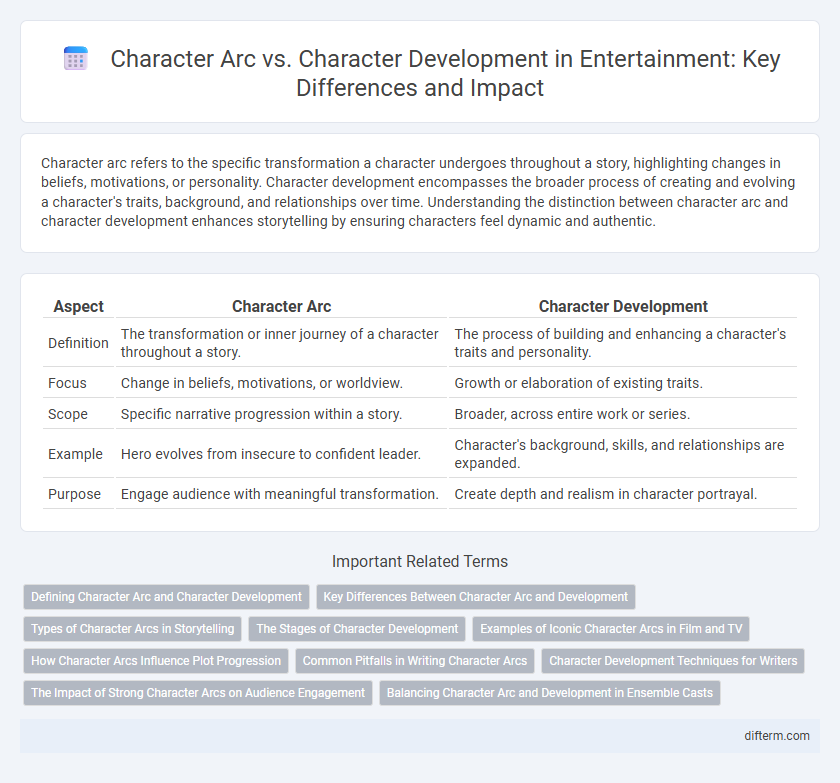Character arc refers to the specific transformation a character undergoes throughout a story, highlighting changes in beliefs, motivations, or personality. Character development encompasses the broader process of creating and evolving a character's traits, background, and relationships over time. Understanding the distinction between character arc and character development enhances storytelling by ensuring characters feel dynamic and authentic.
Table of Comparison
| Aspect | Character Arc | Character Development |
|---|---|---|
| Definition | The transformation or inner journey of a character throughout a story. | The process of building and enhancing a character's traits and personality. |
| Focus | Change in beliefs, motivations, or worldview. | Growth or elaboration of existing traits. |
| Scope | Specific narrative progression within a story. | Broader, across entire work or series. |
| Example | Hero evolves from insecure to confident leader. | Character's background, skills, and relationships are expanded. |
| Purpose | Engage audience with meaningful transformation. | Create depth and realism in character portrayal. |
Defining Character Arc and Character Development
Character arc refers to the specific transformation a character undergoes throughout a story, highlighting changes in beliefs, motivations, or personality. Character development encompasses the broader process of creating and evolving a character's traits, backstory, and relationships to make them relatable and dynamic. Understanding the distinction between these concepts enhances storytelling by ensuring characters are both well-crafted and meaningfully transformed.
Key Differences Between Character Arc and Development
Character arc defines the transformation a character undergoes throughout a story, emphasizing changes in beliefs, motivations, and personality traits that drive the narrative. Character development encompasses the overall buildup of a character's background, personality, and skills, often showcasing complexity without necessarily involving significant change. The key difference lies in character arc focusing on dynamic progression, while development includes both static and evolving elements that enrich the character's depth.
Types of Character Arcs in Storytelling
Character arcs in storytelling include the positive change arc, where the protagonist grows and overcomes flaws, the negative change arc, depicting a decline or moral corruption, and the flat arc, in which the character remains fundamentally the same but influences others. Each type shapes the narrative structure by driving emotional engagement and thematic depth through transformation or steadfastness. Understanding these arc types helps writers craft compelling character journeys that resonate with audiences.
The Stages of Character Development
The stages of character development encompass the transformation a character undergoes throughout a story, including introduction, conflict, growth, and resolution, creating a dynamic and relatable persona. Character arc, as a specific type of development, tracks the emotional or psychological journey that drives changes in beliefs, motivations, or behaviors. Understanding these distinct but interconnected concepts enhances storytelling by ensuring characters evolve in a meaningful and believable manner.
Examples of Iconic Character Arcs in Film and TV
Character arcs illustrate the transformative journeys of characters, exemplified by Walter White in "Breaking Bad," who evolves from a mild-mannered teacher into a ruthless drug lord. In contrast, character development encompasses the broader range of traits and growth, as seen with Forrest Gump in "Forrest Gump," whose consistent kindness and innocence shape his life experiences. Iconic arcs, such as Tony Stark's redemption in "Iron Man," highlight pivotal changes driving plot and audience engagement.
How Character Arcs Influence Plot Progression
Character arcs directly influence plot progression by driving the transformation of characters through conflicts and resolutions, which in turn propel the story forward. As characters evolve, their decisions and growth alter the narrative direction, creating dynamic cause-and-effect relationships within the plot. Well-crafted character arcs ensure that plot developments feel organic, enhancing emotional engagement and thematic depth in entertainment narratives.
Common Pitfalls in Writing Character Arcs
Writers often confuse character arc with character development, leading to shallow or inconsistent growth that undermines the narrative. Common pitfalls include neglecting internal conflict, resulting in static characters, and forcing change without believable motivation, which breaks immersion. Effective character arcs require a seamless blend of personal struggle and transformation driven by well-established goals and obstacles.
Character Development Techniques for Writers
Effective character development techniques for writers include exploring internal conflicts and motivations that drive growth over time, using consistent behavior changes aligned with plot events, and employing dialogue and actions that reveal evolving personality traits. Writers can deepen characters by integrating backstory elements that influence present decisions and by crafting relationships that challenge or support transformation. Visual symbolism and thematic parallels also enhance the subtle portrayal of character development throughout the narrative.
The Impact of Strong Character Arcs on Audience Engagement
Strong character arcs deepen audience engagement by showcasing meaningful transformations that resonate emotionally and psychologically. These arcs create a dynamic narrative flow, allowing viewers to invest in characters' motivations, struggles, and growth over time. In contrast to static character development, well-crafted arcs enhance storytelling by providing clear progression and payoff, crucial for maintaining sustained interest and empathy.
Balancing Character Arc and Development in Ensemble Casts
Balancing character arc and development in ensemble casts requires carefully allocating screen time to ensure each character's journey is meaningful and coherent. Effective storytelling integrates individual arcs with group dynamics, allowing personal growth without overshadowing collective narrative momentum. Maintaining this balance enhances audience engagement by providing diverse perspectives while driving the overall plot forward.
character arc vs character development Infographic

 difterm.com
difterm.com